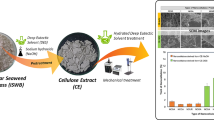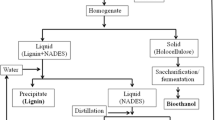Abstract
With the aim to exhibit the advantages of catalytic accelerator in enhancing the selective hydrolysis of cellulose to sugar, cellulose is hydrolyzed in low acid aqueous system with catalytic accelerator. And then sugar products are extracted and fermented by yeast. By the assistance of catalytic accelerator, cellulose conversion rate and total reducing sugar yield are 95.7% and 90.9%. And the glucose yield is as high as 73.6%. The sugar products with high glucose content can be easily extracted from cellulose hydrolysate. Low toxicity of the sugar products to yeast is found during yeast fermentation. The glucose in cellulose hydrolysate can be fully consumed after 12 h. A highly actual ethanol yield is exhibited, which is equal to the actual yield level of standard glucose solution. The important role of catalytic accelerator in aqueous hydrolytic system to produce fermentable sugar is clearly reflected. Furthermore, a simple but effective way is established to efficient utilization of cellulose as an applicable carbon source for the conversion of more value-added chemicals and materials.






Similar content being viewed by others
References
Tian H, He J (2016) Cellulose as a scaffold for self-assembly: from basic research to real applications. Langmuir 32:12269–12282. https://doi.org/10.1021/acs.langmuir.6b02033
Zhu H, Luo W, Ciesielski PN, Fang Z, Zhu JY, Henriksson G, Himmel ME, Hu L (2016) Wood-derived materials for green electronics, biological devices, and energy applications. Chem Rev 116:9305–9374. https://doi.org/10.1021/acs.chemrev.6b00225
Nishio Y (2006) Material functionalization of cellulose and related polysaccharides via diverse microcompositions. Adv Polym Sci 205:97–151. https://doi.org/10.1007/12_095
Huber GW, Iborra S, Corma A (2006) Synthesis of transportation fuels from biomass: chemistry, catalysts, and engineering. Chem Rev 106:4044–4098. https://doi.org/10.1021/cr068360d
Jarvis M (2003) Chemistry: cellulose stacks up. Nature 426:611–612. https://doi.org/10.1038/426611a
Majumdar S, Naha A, Bhattacharyya DK, Bhowal J (2019) Effective delignification and decrystallization of cauliflower wastes by using dilute phosphoric acid for efficient enzymatic digestibility to produce fermentable sugars. Biomass Bioenerg 125:169–179. https://doi.org/10.1016/j.biombioe.2019.04.017
Turner S, Kumar M (2018) Cellulose synthase complex organization and cellulose microfibril structure. Philos Trans A Math Phys Eng Sci 376:1471–1485. https://doi.org/10.1098/rsta.2017.0048
Fernandes AN, Thomas LH, Altaner CM, Callow P, Forsyth VT, Apperley DC, Kennedy CJ, Jarvis MC (2011) Nanostructure of cellulose microfibrils in spruce wood. Proc Natl Acad Sci USA 108:1195–1203. https://doi.org/10.1073/pnas.1108942108
Thomas LH, Forsyth VT, Sturcova A, Kennedy CJ, May RP, Altaner CM, Apperley DC, Wess TJ, Jarvis MC (2013) Structure of cellulose microfibrils in primary cell walls from collenchyma. Plant Physiol 161:465–476. https://doi.org/10.1104/pp.112.206359
Jeoh T, Ishizawa CI, Davis MF, Himmel ME, Adney WS, Johnson DK (2007) Cellulase digestibility of pretreated biomass is limited by cellulose accessibility. Biotechnol Bioeng 98:112–122. https://doi.org/10.1002/bit.21408
Zhu K, Qiu C, Lu A, Luo L, Guo J, Cong H, Chen F, Liu X, Zhang X, Wang H, Cai J, Fu Q, Zhang L (2018) Mechanically strong multifilament fibers spun from cellulose solution via inducing formation of nanofibers. ACS Sustain Chem Eng 6:5314–5321. https://doi.org/10.1021/acssuschemeng.8b00039
Qiao Y, Zhai CK, Liu F, Chen L, Na HN, Chen J, Zhu J (2020) Highly efficient microwave driven assisted hydrolysis of cellulose to sugar with the utilization of ZrO2 to inhibit recrystallization of cellulose. Carbohydr Polym 228:115358. https://doi.org/10.1016/j.carbpol.2019.115358
Ni JP, Wang HL, Chen YY, She Z, Na HN, Zhu J (2013) A novel facile two-step method for producing glucose from cellulose. Bioresour Technol 137:106–110. https://doi.org/10.1016/j.biortech.2013.03.104
Samikannu R, Shukla SK, Samikannu A, Mikkola JP (2019) Lutidinium-based ionic liquids for efficient dissolution of cellulose. New J Chem 43:2299–2306. https://doi.org/10.1039/C8NJ04698K
Martin-Bertelsen B, Andersson E, Kohnke T, Hedlund A, Stigsson L, Olsson U (2020) Revisiting the dissolution of cellulose in NaOH as “seen” by X-rays. Polymer 12:342. https://doi.org/10.3390/polym12020342
Boerstoel H, Maatman H, Westerink JB, Koenders BM (2001) Liquid crystalline solutions of cellulose in phosphoric acid. Polymer 42:7371–7379. https://doi.org/10.1016/S0032-3861(01)00210-5
Bao Y, Xu D, Qian L, Zhao L, Lu ZY, Cui S (2017) Hydrophilicities of amylose and natural cellulose are regulated by the linkage between sugar rings. Nanoscale 9:3382–3385. https://doi.org/10.1039/C7NR00198C
Song J, Fan H, Ma J, Han B (2013) Conversion of glucose and cellulose into value-added products in water and ionic liquids. Green Chem 15:2619–2635. https://doi.org/10.1039/C3GC41141A
Vom Stein T, Grande P, Sibilla F, Commandeur U, Fischer R, de Leitner W, María PD (2010) Salt-assisted organic-acid-catalyzed depolymerization of cellulose. Green Chem 12:1844–1849. https://doi.org/10.1039/C0GC00262C
Li C, Wang Q, Zhao ZK (2008) Acid in ionic liquid: an efficient system for hydrolysis of lignocellulose. Green Chem 10:177–182. https://doi.org/10.1039/B711512A
Kontturi E, Vuorinen T (2008) Indirect evidence of supramolecular changes within cellulose microfibrils of chemical pulp fibers upon drying. Cellulose 16:65–74. https://doi.org/10.1007/s10570-008-9235-3
Kobayashi H, Fukuoka A (2013) Synthesis and utilisation of sugar compounds derived from lignocellulosic biomass. Green Chem 15:1740–1763. https://doi.org/10.1039/C3GC00060E
Zhang YH, Lynd LR (2004) Toward an aggregated understanding of enzymatic hydrolysis of cellulose: noncomplexed cellulase systems. Biotechnol Bioeng 88:797–824. https://doi.org/10.1002/bit.20282
Gusmao MSS, Gopal P, Siloi I, Curtarolo S, Fornari M, Nardelli MB (2019) Mechanical properties of chemically modified clay. Sci Rep 9:13698–13705. https://doi.org/10.1038/s41598-019-49972-7
Zhang X, Xiao B, Chen J, Guo M, Yang Q (2016) Adjusting the acid strength of hybrid solid acids in confined nanospace. Top Catal 59:1748–1756. https://doi.org/10.1007/s11244-016-0696-6
Zhang ZY, Qiao Y, Liu F, Chen J, Na HN, Zhu J (2020) Utilization of hydroxyl-enriched glucose-based carbonaceous sphere (HEGCS) as a catalytic accelerator to enhance the hydrolysis of cellulose to sugar. ACS Appl Mater Inter 12:25693–25699. https://doi.org/10.1021/acsami.9b23540
Zhai CK, Teng N, Pan BH, Chen J, Liu F, Zhu J, Na HN (2018) Revealing the importance of non-thermal effect to strengthen hydrolysis of cellulose by synchronous cooling assisted microwave driving. Carbohydr Polym 197:414–421. https://doi.org/10.1016/j.carbpol.2018.06.031
Cheng B, Cui S (2015) Supramolecular chemistry and mechanochemistry of macromolecules: recent advances by single-molecule force spectroscopy. Top Curr Chem 369:97–134. https://doi.org/10.1007/128_2015_628
Luo Z, Zhang A, Chen Y, Shen Z, Cui S (2016) How big is big enough? Effect of length and shape of side chains on the single-chain enthalpic elasticity of a macromolecule. Macromolecules 49:3559–3565. https://doi.org/10.1021/acs.macromol.6b00247
Ibrahim M, Alaam M, El-Hans H, Jalbout AF, de Leon A (2006) Analysis of the structure and vibrational spectra of glucose and fructose. Ecl. Quím. São Paulo 31:15–21. https://doi.org/10.1590/S0100-46702006000300002
Gao L, Wang F, Gao F, Wang L, Zhao J, Qu Y (2011) Purification and characterization of a novel cellobiohydrolase (PdCel6A) from Penicillium decumbens JU-A10 for bioethanol production. Bioresour Technol 102:8339–8342. https://doi.org/10.1016/j.biortech.2011.06.033
Liu Y, Yu P, Song X, Qu Y (2008) Hydrogen production from cellulose by co-culture of Clostridium thermocellum JN4 and Thermoanaerobacterium thermosaccharolyticum GD17. Hydrogen production from cellulose by co-culture of Int. J Hydrogen Energ 33:2927–2933. https://doi.org/10.1016/j.ijhydene.2008.04.004
Rinaldi R, Palkovits R, Schuth F (2008) Depolymerization of cellulose using solid catalysts in ionic liquids. Angew Chem Int Ed Engl 47:8047–8050. https://doi.org/10.1002/ange.200802879
Deguchi S, Tsujii K, Horikoshi K (2008) Effect of acid catalyst on structural transformation and hydrolysis of cellulose in hydrothermal conditions. Green Chem 10:623–626. https://doi.org/10.1039/B803384F
Drissen RET, Maas RHW, Tramper J, Beeftink HH (2009) Modelling ethanol production from cellulose: separate hydrolysis and fermentation versus simultaneous saccharification and fermentation. Biocatal Biotransfor 27:27–35. https://doi.org/10.1080/10242420802564358
Zhang B, Shi R, Duan W, Luo Z, Lu Z-Y, Cui S (2017) Direct comparison between chemisorption and physisorption: a study of poly(ethylene glycol) by means of single-molecule force spectroscopy. RSC Adv 7:33883–33889. https://doi.org/10.1039/C7RA05779B
Acknowledgements
We are also grateful for the use of HPLC equipment provided by Dr. Yingying Han in Ningbo Institute of Materials Technology and Engineering, Chinese Academy of Sciences.
Funding
This study is funded by the National Natural Science Foundation of China (21978310), the Science and Technology Service Network Plan (KFJ-STS-QYZD-2021–16-002), the “One belt, one road” Projects of China Academy of Sciences (174433KYSB20190082), the Key Projects of Ningbo Public Welfare Science and Technology Plan (2021S020), the Leading Innovative and Entrepreneur Team Introduction Program of Zhejiang (2018R01014), the Natural Science Foundation of Education Department of Liaoning province (LJ2020038), and the Natural Science Foundation of Science and Technology Department of Liaoning Province (2019-ZD-0084).
Author information
Authors and Affiliations
Contributions
Wei Liu, conceptualization, formal analysis, methodology, writing — original draft, and writing — review and editing. Haining Na, conceptualization, formal analysis, methodology, and writing — review and editing. Changhui Hu, formal analysis and validation. Fang Zhou, investigation and writing — review and editing. Zhenyu Zhang, investigation. Zhuo Guo, resources. Jin Zhu, resources. Mian Li: resources.
Corresponding authors
Ethics declarations
Competing interests
The authors declare no competing interests.
Additional information
Publisher's note
Springer Nature remains neutral with regard to jurisdictional claims in published maps and institutional affiliations.
Supplementary Information
Below is the link to the electronic supplementary material.
Rights and permissions
About this article
Cite this article
Liu, W., Na, H., Hu, C. et al. Extraction and yeast fermentation of sugar product from cellulose hydrolysis in low acid aqueous system with catalytic accelerator. Biomass Conv. Bioref. 13, 4343–4351 (2023). https://doi.org/10.1007/s13399-022-03000-3
Received:
Revised:
Accepted:
Published:
Issue Date:
DOI: https://doi.org/10.1007/s13399-022-03000-3




